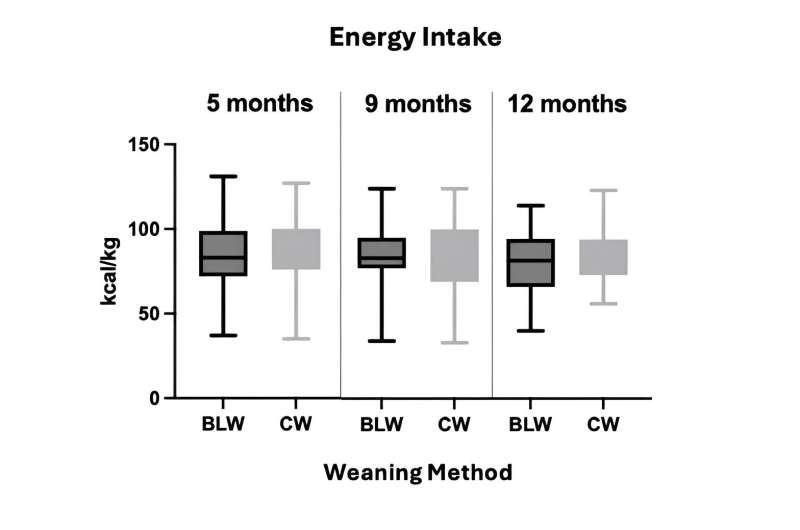New study findings suggest that baby-led weaning—a popular method for introducing solid foods to infants—furnishes ample calories for growth and development. The findings provide evidence-based support for baby-led weaning, which has not been heavily studied.
Baby-led weaning emphasizes allowing infants to hand feed themselves whole, non-pureed foods when introducing solids to infants versus the more traditional approach of spoon-feeding infants pureed solids. Proponents say that it encourages healthy eating habits because babies self-feed and can explore a variety of foods from the family’s meals.
Using data from a large ongoing clinical study known as the Maternal and Infant Nutrition Trial (MINT), researchers showed that baby-led weaning provides the same number of calories per kilogram as conventional weaning and may promote higher growth trajectories.
“One major concern with baby-led weaning was that it wasn’t known whether it provided enough nutrients to support infant growth,” said Kinzie Matzeller, a clinical research coordinator and registered dietitian at the University of Colorado Anschutz Medical Campus. “It is reassuring to know that baby-led weaning provides adequate calories for growth.”
Matzeller presented the findings at NUTRITION 2024, the flagship annual meeting of the American Society for Nutrition held June 29–July 2 in Chicago.

The researchers studied baby-led weaning in a subset of 70 healthy, 5-month-old full-term infants from the MINT study, which is examining how different protein-rich foods impact infant growth and gut health. During the study, caregivers recorded three days of the baby’s intake from all foods, including solid foods and breastmilk or formula. These diet records were used to calculate the baby’s daily intake of all nutrients, including calories and macro- and micronutrients.
The researchers classified a baby as following baby-led weaning if less than 10% of their caloric intake came from pureed baby foods. To calculate the calories and protein that the babies were consuming, they measured the babies’ weight, length and head circumference each month.
“Previous studies have relied on self-reporting for classifying baby-led weaning,” said Matzeller. “The fact that we used data from diet records sets our study apart from previous research and may help provide a more universal definition for baby-led weaning, which would help standardize research on the topic.”
Although no significant differences were seen in energy intake (kcal/kg) between the two weaning groups at any point, the analysis revealed that baby-led weaning was associated with a greater increase in weight-for-age and weight-for-length scores than conventionally weaned infants despite similar energy intake.
These scores indicate whether a child’s weight is considered normal for their age and whether a child’s weight matches their height. The researchers note that more research is needed to fully understand the relationship between feeding method, dietary intake and growth.

They also found that mothers with more education and higher incomes were more likely to use baby-led weaning. Although the reason for this wasn’t studied, the researchers speculate that families with higher incomes might more easily afford the time and resources needed for the food preparation required for baby-led weaning and may be more likely to search for or be exposed to alternative weaning methods.
For parents who want to try baby-led weaning, Matzeller recommends following their babies’ cues and staying flexible with food offerings. She adds that it is important to emphasize a varied and diverse diet when introducing solid foods to infants, regardless of how the food is presented.
Soft fruits, steamed vegetables, cheese and small pieces of meat are all good foods to try for baby-led weaning because they are easy for babies to grasp and chew. Foods should be offered as sticks about the size of the baby’s fist to prevent choking.
“Baby-led weaning can be a great way to incorporate more options and different types of foods your little one may not get otherwise,” said Matzeller. “It often takes up to 15 exposures to a food before a baby accepts it, so persistence is key.”
The researchers plan to continue this line of study in a larger group of babies as the MINT study continues to enroll more participants. They also want to look closer at potential nutritional differences between the weaning methods, such as differences in vitamin and mineral intakes, types of foods and food groups consumed and potential impact on dietary habits as the babies age.
Please note that abstracts presented at NUTRITION 2024 were evaluated and selected by a committee of experts but have not generally undergone the same peer review process required for publication in a scientific journal. As such, the findings presented should be considered preliminary until a peer-reviewed publication is available.
More information:
Matzeller presented this research at 10:12-10:24 a.m. CDT on Sunday, June 30, during the Feeding the Future: Infant Feeding Practices session in McCormick Place (abstract; presentation details).
Citation:
Does baby-led weaning meet nutritional needs? (2024, July 1)
retrieved 1 July 2024
from https://medicalxpress.com/news/2024-07-baby-weaning-nutritional.html
This document is subject to copyright. Apart from any fair dealing for the purpose of private study or research, no
part may be reproduced without the written permission. The content is provided for information purposes only.

